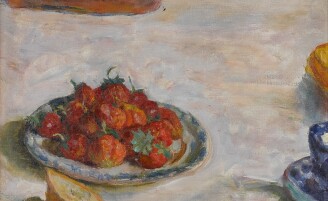W
orks on paper can offer an intimate window into an artist's mind – we observe their process at work, chart their experimentation and growth, and, sometimes, gain a greater understanding of the artist himself. Below, we take a look at important drawings from three of the most revered Modernists of the early twentieth century – Pablo Picasso, Amedeo Modigliani and László Moholy-Nagy – on offer in the Impressionist & Modern Art Day Sale, taking place online from 10 – 19 November.
Amedeo Modigliani, Tête de profil sur un socle, 1913

Amedeo Modigliani completed the present Tête de profil sur un socle in 1913, likely as a study for his signature, elegant Tête sculptures. The present work boosts cherished provenance, having been in the collection of Modigliani's dear friend and advisor, Dr. Paul Alexandre until his death in 1968.
With Modigliani’s works on paper, there is a sense that one can see the artist's mind at work; on viewing the present work, we can almost imagine that it's 1913, and we have the honor of witnessing Modigliani's creative process first-hand.
The extension of the sheet in the present work and the redoubled intensity of line in places only serves to intensify the sense that we are watching Modigliani carve directly out of paper. These effortlessly expressive and mesmeric drawings of his goddesses of stone led to some of the most coveted modern sculptures today, venerable idols of the avant-garde.
ESTIMATE $150,000 – 250,000
László Moholy-Nagy, Composition, 1946

László Moholy-Nagy executed the present Composition in the final year of his life (the artist succumbed to leukemia on 24 November 1946). By 1946, the artist had lived in Chicago for nearly a decade; he first came to the city from Berlin to serve as the director of the New Bauhaus, and subsequently opened the School of Design in Chicago (later the Institute of Design). The United States had an enormous impact on Moholy-Nagy's practice and creative thinking, as he noted in the last few weeks of his life:
“When I came to this country ten years ago, I had to relearn completely my ideas about design. I had thought that European measures could be applied to America immediately with the same results as over there…I never would have believed that a grown-up person could learn as much as I had to learn in this country.”
The present work on paper illustrates the final stage of the artist's creative evolution and is a supreme example of a lifelong interest in the vocabulary of Constructivism and de Stijl: simple geometric forms, balance, line and primary colors.
This artwork comes to Sotheby's from the collection of legendary filmmaker John Hughes.
ESTIMATE $60,000 – 80,000
Pablo Picasso, L'Artiste (A Double-Sided Drawing), 1970

On a single day in 1970, the 20th of July, Picasso executed no fewer than nine iterations of one of the most iconic themes in his oeuvre: the painter and his model. The present work features two of the nine iterations, one on each side of the sheet of paper.
“Picasso painted, drew and etched this subject so many times in his life that, as Michel Leiris has remarked, it almost became a genre in itself like landscape or still-life.”
The contrast between the feminine and masculine personae of the artist in the recto and verso of the present sheet is one of the most striking elements of this double-sided drawing, a contrast which is found to differing degrees in all nine works. It is typical of later variations of this theme that the male (and female) figures are seen in assorted costumes and performing various activities, such as the musketeer on the verso. Picasso always painted without a palette and without an easel, directly onto a canvas laid flat, so the characteristics of an artist’s studio which he incorporates in this series can be considered as stage props which act as shorthand for his profession rather than an accurate record, just as his last love and wife, Jacqueline, never formally posed as Picasso’s model but whose essence is always present in his female portraits of this period.
This artwork comes to Sotheby's from the collection of legendary filmmaker John Hughes.
ESTIMATE $250,000 – 350,000











